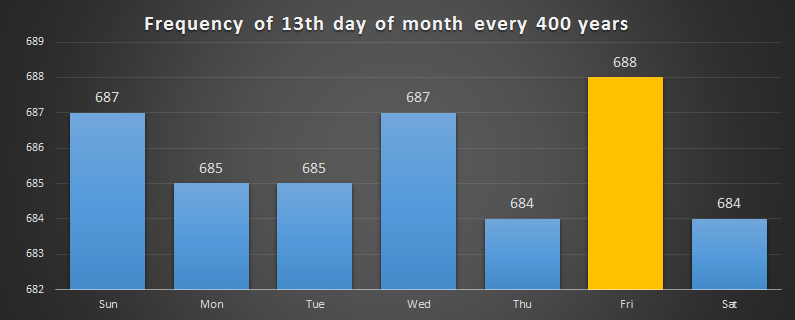
Image via les affaires.
Today, Friday, July 13, 2018, is the second of two Friday the 13ths in 2018. Any calendar year has one to three Friday the 13ths. The last time we had only one Friday the 13th in a calendar year was in May 2016 and the next time won’t be until August 2021. Three Friday the 13ths last took place in 2015 (February, March, November), and will next happen in 2026. This year, 2018, has two Friday the 13ths (April and July).
Not that we at EarthSky suffer from friggatriskaidekaphobia – an irrational fear of Friday the 13th – but, gosh darn, this year’s first Friday the 13th on April 13, 2018, happened exactly 26 weeks (2 x 13 weeks) after the previous Friday the 13th in October 2017. But that’s hardly the end of the tale. Today’s Friday the 13th (July 13), comes exactly 13 weeks after the year’s first Friday the 13th on April 13, 2018.
Next year, in 2019, the first Friday the 13th of the year in September 2019 will come exactly 13 weeks before the second Friday the 13th in December 2019.
Yikes, these few coincidences involving the number 13 are only the tip of the iceberg. We could cite many more …
Keep reading to investigate the intriguing mathematics behind Friday the 13th and the calendar.

Gioachino Rossini, a 19th century Italian composer. Folklorists say there's no written evidence that Friday the 13th was considered unlucky before the 19th century. The earliest known documented reference in English appears to be in Henry Sutherland Edwards' 1869 biography of Rossini.
Are all these Friday the 13ths a super coincidence? Super unlucky? Neither. They’re just a quirk of our calendar.
According to folklorists, there’s no written evidence that Friday the 13th was considered unlucky before the 19th century. The earliest known documented reference in English appears to be in Henry Sutherland Edwards’ 1869 biography of Gioachino Rossini.
Still, Friday has always gotten a bad rap. In the Middle Ages, people would not marry – or set out on a journey – on a Friday.
There are also some links between Christianity and an ill association with either Fridays or the number 13. Jesus was said to be crucified on a Friday. Seating 13 people at a table was seen as bad luck because Judas Iscariot, the disciple who betrayed Jesus, is said to have been the 13th guest at the Last Supper. Meanwhile, our word for Friday comes from Frigga, an ancient Scandinavian fertility and love goddess. Christians called Frigga a witch and Friday the witches’ Sabbath.
In modern times, the slasher-movie franchise Friday the 13th has helped keep friggatriskaidekaphobia alive.

The Friday the 13th slasher-movie franchise helped this day maintain its notoriety. Image via Wikimedia Commons.
We have two Friday the 13ths in 2018 – in April and July – because 2018 is a common year that started on a Monday. Whenever a common year of 365 days starts on a Monday, it’s inevitable that the months of April and July will start on a Sunday. And any month starting on a Sunday will have a Friday the 13th.
The last time a common year started on a Monday was 11 years ago, in the year 2007, and the next time will be 11 years from 2018, in 2029.
In 2018, Easter Sunday came on April 1, 2018, and a solar eclipse occurs on Friday, July 13, 2018. Eleven years and 22 years from now, in the years 2029 and 2040, we’ll again have Friday the 13ths in April and July. Quite by coincidence – or so it seems – Easter Sunday will again fall on April 1, 2029, and April 1, 2040.
Some of you may wonder if there’s some formula that governs how the Friday the 13th drama repeats itself. The answer is yes! Keep in mind that this twofold April-July Friday the 13th year can only happen during a common year of 365 days, and when January 1 falls on a Monday. Let the intriguing number play begin…
Any calendar year that comes two years after a leap year, as it does in 2018, will have days recurring on the same calendar dates in periods of 11, 17 and 28 years. Therefore, the years 2029, 2035 and 2046 will present twofold April and July Friday the 13ths:
2018 + 11 = 2029
2018 + 17 = 2035
2018 + 28 = 2046
Calendar for 2018

2018 calendar via TimeandDate.
How often do April-July Friday the 13ths happen? More often than you might imagine! The first twofold April-July Friday the 13th year in the 21st century (2001 to 2100) occurred in 2001, which is one year after a leap year. Any calendar year happening one year after a leap year will have days and dates matching up again in periods of 6, 17 and 28 years:
2001 + 6 = 2007
2001 + 17 = 2018
2001 + 28 = 2029
We continue the cycle onward to find a grand total of 11 April-July Friday the 13th years for the 21st century (2001 to 2100):
2001, 2007, 2018, 2029, 2035, 2046, 2057, 2063, 2074, 2085 and 2091
Because the year 2085 is one year after a leap year, with days aligning with dates in 6, 17 and 28 years, we might be tempted to project the three following April-July Friday the 13th years as follows:
2085 + 6 = 2091
2085 + 17 = 2102
2085 + 28 = 2113
Alas, here’s where the Gregorian calendar throws a monkey wrench at us. By Gregorian calendar rules, century years not equally divisible by 400 (e.g. 2100, 2200, 2300) are not leap years of 366 days – but rather, common years of 365 days. So the suppression of the leap year in 2100 “perturbs” the cycle, bringing about the first April-July Friday the 13th year of the 22nd century (2101 to 2200) in the year 2103, instead of 2102.
By good fortune, we can pretend that the year 2103 comes three years after a leap year, to project the recurrence of April-July Friday the 13th years in periods of 11, 22 and 28 years.
2103 + 11 = 2114
2103 + 22 = 2125
2103 + 28 = 2131
We continue the cycle onward to find a total of 11 April-July Friday the 13th years for the 22nd century (2100 to 2200):
2103, 2114, 2125, 2131, 2142, 2153, 2159, 2170, 2181, 2187 and 2198
In the 23rd century (2201 to 2300), the cycle is perturbed again. The first April-July Friday the 13th year does not fall in 2209 – but rather in 2210, which is two years after a leap year. Any calendar year happening two years after a leap year recurs in 11, 17 and 28 years.
Thus, we find 11 April-July Friday the 13th years for the 23rd century (2201 to 2300):
2210, 2221, 2227, 2238, 2249, 2255, 2266, 2277, 2283, 2294 and 2300
In the 24th century (2301 to 2400), the cycle is again perturbed. The first January-October Friday the 13th year does not come in 2311 – but rather in 2306, or two years after a leap year (recurring in cycles of 11, 17 and 28 years). That gives 11 April-July Friday the 13th years for the 24th century (2301 to 2400):
2306, 2317, 2323, 2334, 2345, 2351, 2362, 2373, 2379, 2390 and 2401
Because the year 2400 is a leap year of 366 days, the cycle is not perturbed in the following 25th century (2401 to 2500). So we can keep on going to find 11 April-July Friday the 13th years for the 25th century (2401 to 2500).
2401, 2407, 2418, 2429, 2435, 2446, 2457, 2463, 2474, 2485 and 2491

Statistically speaking … the modal day for the 13th to occur on is Friday, with 688 occurrences in the 4,800-month cycle. (Of course, this is the same graph for the 6th as well as the 13th, 20th and 27th.) Caption and graphic via datagenetics.com.
Rhyme and reason for the 400-year Friday the 13th cycle.
Because the Gregorian calendar has a 400-year cycle, the twofold April-July Friday the 13th years recur in cycles of 400 years. For example, respective April-July Friday the 13th calendar years are exactly 400 years apart in the 21st and 25th centuries:
21st century (2001 to 2100):
2001, 2007, 2018, 2029, 2035, 2046, 2057, 2063, 2074, 2085 and 2091
25th century (2401 to 2500):
2401, 2407, 2418, 2429, 2435, 2446, 2457, 2463, 2474, 2485 and 2491
As magical as all of this Friday the 13th calendar intrigue appears to be, it’s not supernatural. It’s entertaining number play, even if it may haunt our uncomprehending minds.
Can April-July Friday the 13ths happen in a leap year?
Yes, if the leap year of 366 days starts on a Sunday. That means there’s a Friday, January 13th, in the mix, too, featuring a total of three Friday the 13ths! This last occurred in the year 2012 and will next happen in 2040. Any leap year starting on a Sunday has three Friday the 13ths: January 13 – and then 13 weeks later, on April 13, and then 13 weeks after that, on July 13. The days and dates of any leap year match up again in periods of 28 years. So we have only four January-April-July Friday the 13th years in the 21st century (2001 to 2100):
2012, 2040, 2068 and 2096

“… and whether or not it is clear to you, the universe is unfolding as it should.” Resin, acrylic paint and archival print on transparency on panel, by Boston artist Jessica Dunegan.
Bottom line: Scared of Friday the 13th? It’s just a feature of our Gregorian calendar, and a pretty common one at that.
from EarthSky https://ift.tt/2qtDIdl

Image via les affaires.
Today, Friday, July 13, 2018, is the second of two Friday the 13ths in 2018. Any calendar year has one to three Friday the 13ths. The last time we had only one Friday the 13th in a calendar year was in May 2016 and the next time won’t be until August 2021. Three Friday the 13ths last took place in 2015 (February, March, November), and will next happen in 2026. This year, 2018, has two Friday the 13ths (April and July).
Not that we at EarthSky suffer from friggatriskaidekaphobia – an irrational fear of Friday the 13th – but, gosh darn, this year’s first Friday the 13th on April 13, 2018, happened exactly 26 weeks (2 x 13 weeks) after the previous Friday the 13th in October 2017. But that’s hardly the end of the tale. Today’s Friday the 13th (July 13), comes exactly 13 weeks after the year’s first Friday the 13th on April 13, 2018.
Next year, in 2019, the first Friday the 13th of the year in September 2019 will come exactly 13 weeks before the second Friday the 13th in December 2019.
Yikes, these few coincidences involving the number 13 are only the tip of the iceberg. We could cite many more …
Keep reading to investigate the intriguing mathematics behind Friday the 13th and the calendar.

Gioachino Rossini, a 19th century Italian composer. Folklorists say there's no written evidence that Friday the 13th was considered unlucky before the 19th century. The earliest known documented reference in English appears to be in Henry Sutherland Edwards' 1869 biography of Rossini.
Are all these Friday the 13ths a super coincidence? Super unlucky? Neither. They’re just a quirk of our calendar.
According to folklorists, there’s no written evidence that Friday the 13th was considered unlucky before the 19th century. The earliest known documented reference in English appears to be in Henry Sutherland Edwards’ 1869 biography of Gioachino Rossini.
Still, Friday has always gotten a bad rap. In the Middle Ages, people would not marry – or set out on a journey – on a Friday.
There are also some links between Christianity and an ill association with either Fridays or the number 13. Jesus was said to be crucified on a Friday. Seating 13 people at a table was seen as bad luck because Judas Iscariot, the disciple who betrayed Jesus, is said to have been the 13th guest at the Last Supper. Meanwhile, our word for Friday comes from Frigga, an ancient Scandinavian fertility and love goddess. Christians called Frigga a witch and Friday the witches’ Sabbath.
In modern times, the slasher-movie franchise Friday the 13th has helped keep friggatriskaidekaphobia alive.

The Friday the 13th slasher-movie franchise helped this day maintain its notoriety. Image via Wikimedia Commons.
We have two Friday the 13ths in 2018 – in April and July – because 2018 is a common year that started on a Monday. Whenever a common year of 365 days starts on a Monday, it’s inevitable that the months of April and July will start on a Sunday. And any month starting on a Sunday will have a Friday the 13th.
The last time a common year started on a Monday was 11 years ago, in the year 2007, and the next time will be 11 years from 2018, in 2029.
In 2018, Easter Sunday came on April 1, 2018, and a solar eclipse occurs on Friday, July 13, 2018. Eleven years and 22 years from now, in the years 2029 and 2040, we’ll again have Friday the 13ths in April and July. Quite by coincidence – or so it seems – Easter Sunday will again fall on April 1, 2029, and April 1, 2040.
Some of you may wonder if there’s some formula that governs how the Friday the 13th drama repeats itself. The answer is yes! Keep in mind that this twofold April-July Friday the 13th year can only happen during a common year of 365 days, and when January 1 falls on a Monday. Let the intriguing number play begin…
Any calendar year that comes two years after a leap year, as it does in 2018, will have days recurring on the same calendar dates in periods of 11, 17 and 28 years. Therefore, the years 2029, 2035 and 2046 will present twofold April and July Friday the 13ths:
2018 + 11 = 2029
2018 + 17 = 2035
2018 + 28 = 2046
Calendar for 2018

2018 calendar via TimeandDate.
How often do April-July Friday the 13ths happen? More often than you might imagine! The first twofold April-July Friday the 13th year in the 21st century (2001 to 2100) occurred in 2001, which is one year after a leap year. Any calendar year happening one year after a leap year will have days and dates matching up again in periods of 6, 17 and 28 years:
2001 + 6 = 2007
2001 + 17 = 2018
2001 + 28 = 2029
We continue the cycle onward to find a grand total of 11 April-July Friday the 13th years for the 21st century (2001 to 2100):
2001, 2007, 2018, 2029, 2035, 2046, 2057, 2063, 2074, 2085 and 2091
Because the year 2085 is one year after a leap year, with days aligning with dates in 6, 17 and 28 years, we might be tempted to project the three following April-July Friday the 13th years as follows:
2085 + 6 = 2091
2085 + 17 = 2102
2085 + 28 = 2113
Alas, here’s where the Gregorian calendar throws a monkey wrench at us. By Gregorian calendar rules, century years not equally divisible by 400 (e.g. 2100, 2200, 2300) are not leap years of 366 days – but rather, common years of 365 days. So the suppression of the leap year in 2100 “perturbs” the cycle, bringing about the first April-July Friday the 13th year of the 22nd century (2101 to 2200) in the year 2103, instead of 2102.
By good fortune, we can pretend that the year 2103 comes three years after a leap year, to project the recurrence of April-July Friday the 13th years in periods of 11, 22 and 28 years.
2103 + 11 = 2114
2103 + 22 = 2125
2103 + 28 = 2131
We continue the cycle onward to find a total of 11 April-July Friday the 13th years for the 22nd century (2100 to 2200):
2103, 2114, 2125, 2131, 2142, 2153, 2159, 2170, 2181, 2187 and 2198
In the 23rd century (2201 to 2300), the cycle is perturbed again. The first April-July Friday the 13th year does not fall in 2209 – but rather in 2210, which is two years after a leap year. Any calendar year happening two years after a leap year recurs in 11, 17 and 28 years.
Thus, we find 11 April-July Friday the 13th years for the 23rd century (2201 to 2300):
2210, 2221, 2227, 2238, 2249, 2255, 2266, 2277, 2283, 2294 and 2300
In the 24th century (2301 to 2400), the cycle is again perturbed. The first January-October Friday the 13th year does not come in 2311 – but rather in 2306, or two years after a leap year (recurring in cycles of 11, 17 and 28 years). That gives 11 April-July Friday the 13th years for the 24th century (2301 to 2400):
2306, 2317, 2323, 2334, 2345, 2351, 2362, 2373, 2379, 2390 and 2401
Because the year 2400 is a leap year of 366 days, the cycle is not perturbed in the following 25th century (2401 to 2500). So we can keep on going to find 11 April-July Friday the 13th years for the 25th century (2401 to 2500).
2401, 2407, 2418, 2429, 2435, 2446, 2457, 2463, 2474, 2485 and 2491

Statistically speaking … the modal day for the 13th to occur on is Friday, with 688 occurrences in the 4,800-month cycle. (Of course, this is the same graph for the 6th as well as the 13th, 20th and 27th.) Caption and graphic via datagenetics.com.
Rhyme and reason for the 400-year Friday the 13th cycle.
Because the Gregorian calendar has a 400-year cycle, the twofold April-July Friday the 13th years recur in cycles of 400 years. For example, respective April-July Friday the 13th calendar years are exactly 400 years apart in the 21st and 25th centuries:
21st century (2001 to 2100):
2001, 2007, 2018, 2029, 2035, 2046, 2057, 2063, 2074, 2085 and 2091
25th century (2401 to 2500):
2401, 2407, 2418, 2429, 2435, 2446, 2457, 2463, 2474, 2485 and 2491
As magical as all of this Friday the 13th calendar intrigue appears to be, it’s not supernatural. It’s entertaining number play, even if it may haunt our uncomprehending minds.
Can April-July Friday the 13ths happen in a leap year?
Yes, if the leap year of 366 days starts on a Sunday. That means there’s a Friday, January 13th, in the mix, too, featuring a total of three Friday the 13ths! This last occurred in the year 2012 and will next happen in 2040. Any leap year starting on a Sunday has three Friday the 13ths: January 13 – and then 13 weeks later, on April 13, and then 13 weeks after that, on July 13. The days and dates of any leap year match up again in periods of 28 years. So we have only four January-April-July Friday the 13th years in the 21st century (2001 to 2100):
2012, 2040, 2068 and 2096

“… and whether or not it is clear to you, the universe is unfolding as it should.” Resin, acrylic paint and archival print on transparency on panel, by Boston artist Jessica Dunegan.
Bottom line: Scared of Friday the 13th? It’s just a feature of our Gregorian calendar, and a pretty common one at that.
from EarthSky https://ift.tt/2qtDIdl

Aucun commentaire:
Enregistrer un commentaire